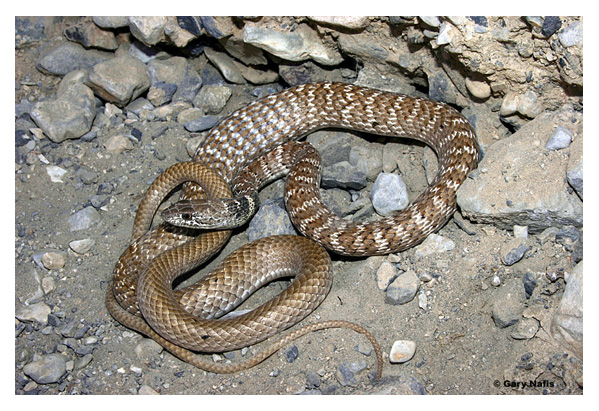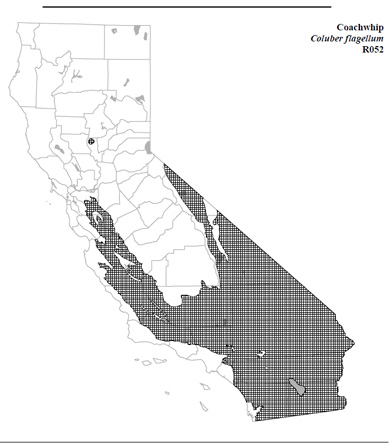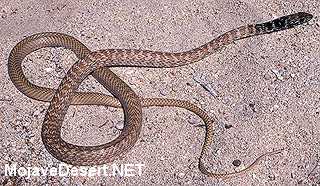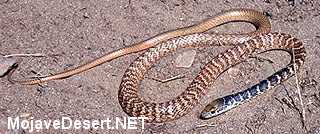Coachwhip Snake
Red racer
Coluber (Masticophis) flagellum
Family: Colubridae Order: Squamata Class: Reptilia
DISTRIBUTION, ABUNDANCE, AND SEASONALITY
Coachwhips are common to uncommon in arid regions below 2350 m (7700 ft) in
California (Stebbins 1985). They are found in the deserts south of Mono Co. and the foothills
of the coast ranges south of San Francisco Bay. There is an isolated population in the Sutter
Buttes, Sutter Co. (Hayes and Cliff 1982). Coachwhips occur in open terrain and are most
abundant in grass, desert, scrub, chaparral, and pasture habitats (Wilson 1970, Stebbins
1972).
SPECIFIC HABITAT REQUIREMENTS
Feeding: Diet consists of rodents, lizards and eggs, snakes (including rattlesnakes),
birds and eggs, young turtles, insects, and carrion (Cowles 1946, Stebbins 1954, Wright
and Wright 1957, Carpenter 1958, Cunningham 1959, Miller and Stebbins 1964).
Coachwhips search actively for prey, with their heads elevated. They poke their heads in
burrows, or climb trees, using both vision and olfaction to detect prey (Stebbins 1954, 1985,
Miller and Stebbins 1964), which is consumed alive and whole (Ortenburger 1928, Stebbins
1954, 1985).
Cover: Coachwhips seek cover in rodent burrows, bushes, trees, and rock piles (Stebbins
1954, 1985, Miller and Stebbins 1964). They hibernate in soil or sand approximately 0.3 m
(1 ft) below the surface, sometimes at the bases of plants (Wright and Wright 1957).
Reproduction: Little is known about nest sites. One was recorded on the bank of a
highway drainage ditch, approximately 0.3 m (1 ft) beneath the ground surface (Wright and
Wright 1957).
Water: In desert regions, coachwhips may be attracted to water to drink or ambush prey
(Miller and Stebbins 1964).
Pattern: Open habitats are preferred.
SPECIES LIFE HISTORY
Activity Patterns: Diurnal. Coachwhips are usually active mid-morning and late afternoon
(Miller and Stebbins 1964) from March through October (Wright and Wright 1957).
Seasonal Movements/Migration: No data.
Home Range: No data.
Territory: No data.
Reproduction: Mating occurs in April and May, eggs are laid June and July, and the first
young appear in late August or early September (Stebbins 1954, Wright and Wright 1957,
Fitch 1970). Clutch size ranges from 4 to 16 eggs with a mean of 8 to 10 (Stebbins 1954,
Wright and Wright 1957, Carpenter 1958, Cunningham 1959, Fitch 1970). The incubation
period in the lab is 76-79 days (Stebbins 1954).
Niche: Coachwhips are mainly terrestrial, but occasionally climb trees and bushes to
bask, seek prey and cover. These aggressive snakes will bite if captured. They are able to
move rapidly, up to 12.8km (8 mi) per hour (Stebbins 1954, 1985, Miller and Stebbins 1964).
Hawks are probable predators, and roadrunners may feed on young coachwhips.
Also see:
Joshua Tree National Park Wildlife
Red Coachwhip Masticophis flagellum piceus Prefers open areas with high visibility (common) California Striped Racer Masticophis lateralis lateralis ...
Death Valley Snakes
Western Coachwhip (Red Racer) Masticophis flagellum piceus Common throughout park; often seen crossing roads; very fast and heat-tolerant; an agressive snake ...
Ash Meadows
Coachwhip and gopher snakes are two of the more common snakes seen at Ash Meadows. During the heat of mid-summer, many reptiles and amphibians become ...
Source:
CDFW California Wildlife Habitat Relationships. Accessed [N/A]
https://wildlife.ca.gov/Data/CWHR


Coachwhip
Photo by Chris Brown

Coachwhip
Photo by Chris Brown
Additional information:
Scientific name: Masticophis flagellum piceus
Common name: Red Coachwhip or Red Racer
Size: 24.4-54.3 in (62-138 cm)
Distinguishing characters: A species with highly variable dorsal coloration; tan, grey, red, or pink with bold black or brown crossbars or blotches on neck which may blend together; venter pink; slender body and tail; large eyes with round pupils; often described as a red snake with a black head.
Juveniles: Black, brown or tan transverse bands on lighter background; black neck markings absent in hatchlings and faint in juveniles less than 24 in (61 cm) in length.
Dimorphism: None
Similar species: Masticophis lateralis: Has distinct yellow lateral stripes.
Additional notes: A fast moving diurnal snake that is difficult to capture. Bites, excretes musk and twists body when handled. Large individuals should be handled with caution.
The fastest snake in the Mojave, it moves about during the day in search of grasshoppers, lizards and small rodents. When threatened, it imitates a rattlesnake by curling into a striking position and vibrating its tail.